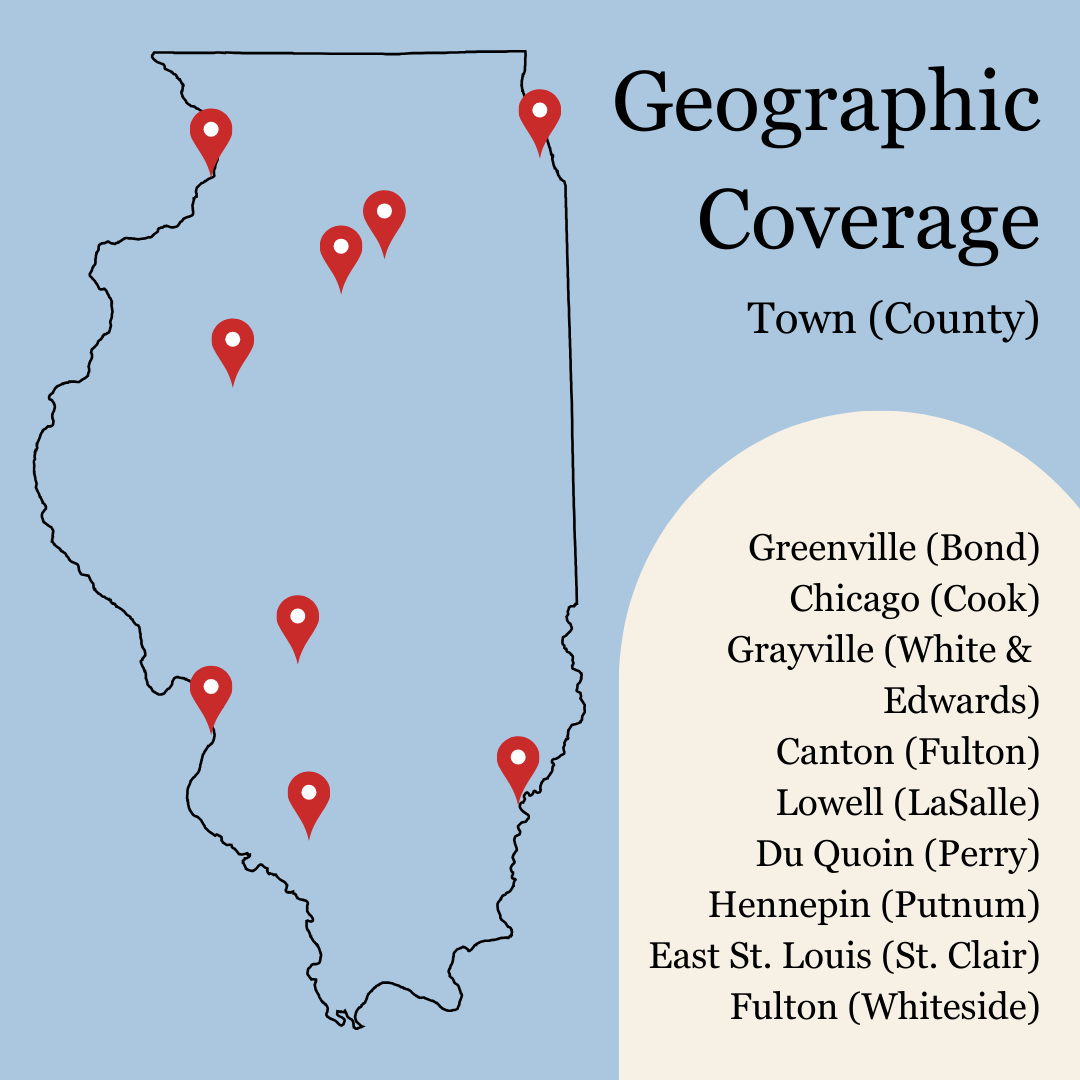The Illinois Newspaper Project is thrilled to announce that the advisory board has selected the following newspapers for the National Digital Newspaper Program (NDNP) digitization grant:

- Canton Weekly register (Canton, Ill.) 1852-1914
- The citizen / Irish news and Chicago citizen / The Chicago citizen (Chicago, Ill.), 1882-1928
- The Du Quoin tribune (Du Quoin, Ill.), 1867-1871
- East St. Louis daily journal (East St. Louis, Ill.), 1910-1928
- Fulton journal (Fulton, Ill.), 1877-1879
- Genius of liberty (Lowell, Ill.), 1840-1842
- Genius of universal emancipation (Hennepin, Ill.), 1838-1839
- The Grayville herald (Grayville, Ill.), 1855-1858
- The Greenville advocate (Greenville, Ill.), 1858-1864
The selected newspapers illuminate the geographic, industrial, economic, and cultural histories of 19th and early 20th century Illinois. These newspapers will support research in a number of areas, including the Civil War era; periods of industrial and economic growth in Illinois, particularly in river towns; migrations and urbanizations of Illinois towns; agricultural and rural histories; the abolitionist movement and formation of state abolitionist societies; and the years comprising and surrounding the 1917 East St. Louis race riots. The inclusion of the Chicago Citizen will provide insight into the Irish immigrant experience in America and will also make accessible one of the first Gaelic-language newspaper columns. Newspapers will also prove helpful in genealogical research and in researching local and regional social histories of Illinois towns, including many which were not previously included in Chronicling America or the Illinois Digital Newspaper Collections.
A big thank you to all who submitted a nomination!
This was the first year that the Illinois Newspaper Project has hosted a nomination process to select titles for NDNP digitization. We received over 60 nominations and are astounded by the reception of this opportunity. Thank you to everyone who submitted a nomination! All nominated newspapers will be filed as potential candidates for future digitization opportunities.
As a reminder, the selected newspapers will be digitized as part of the National Digital Newspaper Program (NDNP), a partnership between the National Endowment for the Humanities (NEH) and the Library of Congress (LC). These titles will be included in Chronicling America, the national digital newspaper database hosted by the Library of Congress, as well as the Illinois Digital Newspaper Collections, administered by the Illinois Newspaper Project.
Learn more about the selected newspapers:

Canton Weekly register
Canton, Fulton County, Ill.
Digitization dates: 1852-1914
Nominated by Western Illinois University Archives & Special Collections
“Beginning in the late 1840s, Canton and the rest of the northeastern part of Fulton County began industrializing. By the 1860s, coal mining also became a major industry in the county. The editors of the Register had a Republican lean, which is interesting for the Civil War period. By the end of our microfilm run, the period covered will also mention the beginnings of immigration to Fulton County, especially from Italy and Croatia (Austria-Hungary). It should be noted that many of the above are usually considered urban issues, yet Fulton County remained rural.”
The citizen / The Chicago citizen / The Irish news and Chicago citizen / Chicago citizen
Chicago, Cook County, Ill.
Digitization dates: 1882-1928
Nominated by Abraham Lincoln Presidential Library on behalf of an individual
“In 1882, John F. Finerty founded the Citizen, a weekly newspaper in Chicago that advocated for the social and political advancement of the Irish people in America and offered a “wider opportunity to express sympathy with the cause of their motherland.” Finerty declared that the Citizen would advocate for the independence of Ireland from British rule by any means necessary, even adding to the masthead: “Europe, not England, is the Mother Country of America.” This is significant, for many Irish immigrants to America—in particular those coming in the Famine decade 1845-1855—saw themselves as exiles, driven out of their homeland by cruel British policies and an oppressive landlord class. These Irish immigrants embraced America and its freedoms, but frequently faced nativist attacks on their Catholic religion, their poverty, their culture, and their growing influence on elections. As such, a newspaper like the Citizen offered the Irish in the Midwest a way to remain intricately connected to the land of their birth, while simultaneously encouraging them to improve their standing in America…Further, in 1883 the Citizen began publishing a weekly column in the Irish language—one of only a handful of such columns in the world…Although the circulation never extended beyond 15,000, it regularly included columns and letters contributed from Ireland and Canada. Digitizing this newspaper will open up many avenues of scholarship for the Irish in America and worldwide, offering unique Chicago-centered takes on citizenship, politics, nationalism, religion, immigration, and, perhaps most importantly, identity.”
The Du Quoin Tribune
Du Quoin, Perry County, Ill.
Digitization dates: 1867-1871
Nominated by Du Quoin Public Library
“The Du Quoin Tribune discusses countywide happenings in Perry County and national and global events, including local, state, and presidential elections, city council proceedings, and post office notices… Some of the towns mentioned within the microfilmed pages include the names of towns that no longer exist, exist unincorporated, or that exist now under another name. News of St. Louis is often mentioned, as the closest city, and levees of the Mississippi River are discussed, particularly when at risk. For genealogical purposes, death notices are included. Geographically, Du Quoin is an agricultural and a mining community, and hints for farmers are included. The nature of the area has changed as mines have shifted, roads have been created, and farming land has matured.”
East St. Louis daily journal / The daily journal
East St. Louis, St. Clair County, Ill.
Digitization dates: 1910-1928
Nominated by St. Clair County Historical Society
“…These newspapers covered the apex of East St. Louis’s influence as a nexus for industry, commerce, migration, and transportation. It covers the Great Migration, when East St. Louis’s Black community grew and gained influence. Perhaps most central from a wider perspective, these volumes cover the horrific race massacre of 1917. This tragic event laid bare the racial tensions of the time, often called the nadir of American race relations. The violence which erupted echoed across the country. Following the race massacre, the city experienced a period of rebuilding and felt the pressures of the incipient Great Depression.”
Nominated by St. Clair County Genealogical Society
“We nominate the East St. Louis Journal from 1910-1928, a period of growth and unrest, for digitization as this resource should be freely available online for researchers to understand the East St. Louis of yesterday.”
The Fulton journal
Fulton, Whiteside County, Ill.
Digitization dates: 1877-1879
Nominated by Schmaling Memorial Public Library District
“Once steamboats became popular along the Mississippi, Fulton was an important river port due to its railroad connections. The Fulton Journal regularly published information about the steamboats operating on the upper Mississippi, including lists of commercial boats, captains, and pilots, a veritable treasure trove for researchers of the steamboat trade on the Mississippi. Because Fulton was also a railroad hub in the later 1800’s, The Fulton Journal often featured columns on railroad news as well, including those featuring the building of the railroad bridges across the Mississippi from Fulton to Clinton, IA, some of the first to cross the great river… the early papers held a wealth of personal touches in the society columns where one could often read about one’s neighbors’ doings such as family visits, anniversaries, parties, etc. Local functions were covered, often including mentions of many of the guests in attendance. Additionally, The Fulton Journal very often covered the arrival of immigrants to town, including lists of said immigrants, particularly after Dutch immigrants began arriving in town in fairly large numbers from 1866 on.”
Genius of liberty
Lowell, LaSalle County, Ill.
Digitization dates: 1840-1842
Nominated by Abraham Lincoln Presidential Library on behalf of an individual
Genius of universal emancipation
Hennepin, Putnam County, Ill.
Digitization dates: 1838-1839
Nominated by Abraham Lincoln Presidential Library on behalf of an individual
“These two papers are interconnected, and both are essential to the history of abolitionism and civil rights organizing in nineteenth-century Illinois… Digital access to these newspapers will help students and researchers learn about the history of antislavery organizing and also about Black settlement, Black political organizing, the movement to repeal the Illinois “black laws,” and the early career of [Zebina] Eastman [editor] himself. These invaluable resources touch on the long history of anti-racist organizing in Illinois and resonate in the present as Americans continue to confront the legacies of slavery.”
The Grayville herald / Grayville weekly herald
Grayville, Edgar and White Counties, Ill.
Digitization dates: 1855-1858
Nominated by Groff Memorial Public Library & Museum
“Grayville was a true frontier town with settlement of the area beginning at least by 1809. Being situated on the Wabash, commerce and transportation grew via land and river transport. As the town grew, the population spread into Edwards County as well. Grayville became a center of commerce for fur and meat trading, which then grew into grain, milling, lumber and livestock commerce. Steamboats docked in Grayville regularly, and the area was further settled by a large number of German immigrants. Many cleared land and became farmers. The Grayville Herald, covering 1855 to 1858, offers a glimpse into rural life and the beginnings of settlement, agriculture, business and economic growth in the early days of Grayville and southeastern Illinois.”
The Greenville Advocate
Greenville, Bond County, Ill.
Digitization dates: 1858-1864
Nominated by Bond County Historical Society
“Jediah F. Alexander first published The Greenville Advocate in February 1858 to take a stand for the preservation of the Union. It was one of the few newspapers to support the candidacy of Abraham Lincoln for president…As Bond County’s primary newspaper, The Greenville Advocate has documented the activities and concerns of rural Bond County as well as important historical events for more than over 165 years…The Greenville Advocate covers a wide range of materials such as birth announcements, anniversaries, graduations, illness reports, obituaries, court cases, business profiles, and sports results, making it an indispensable tool for historical research.”